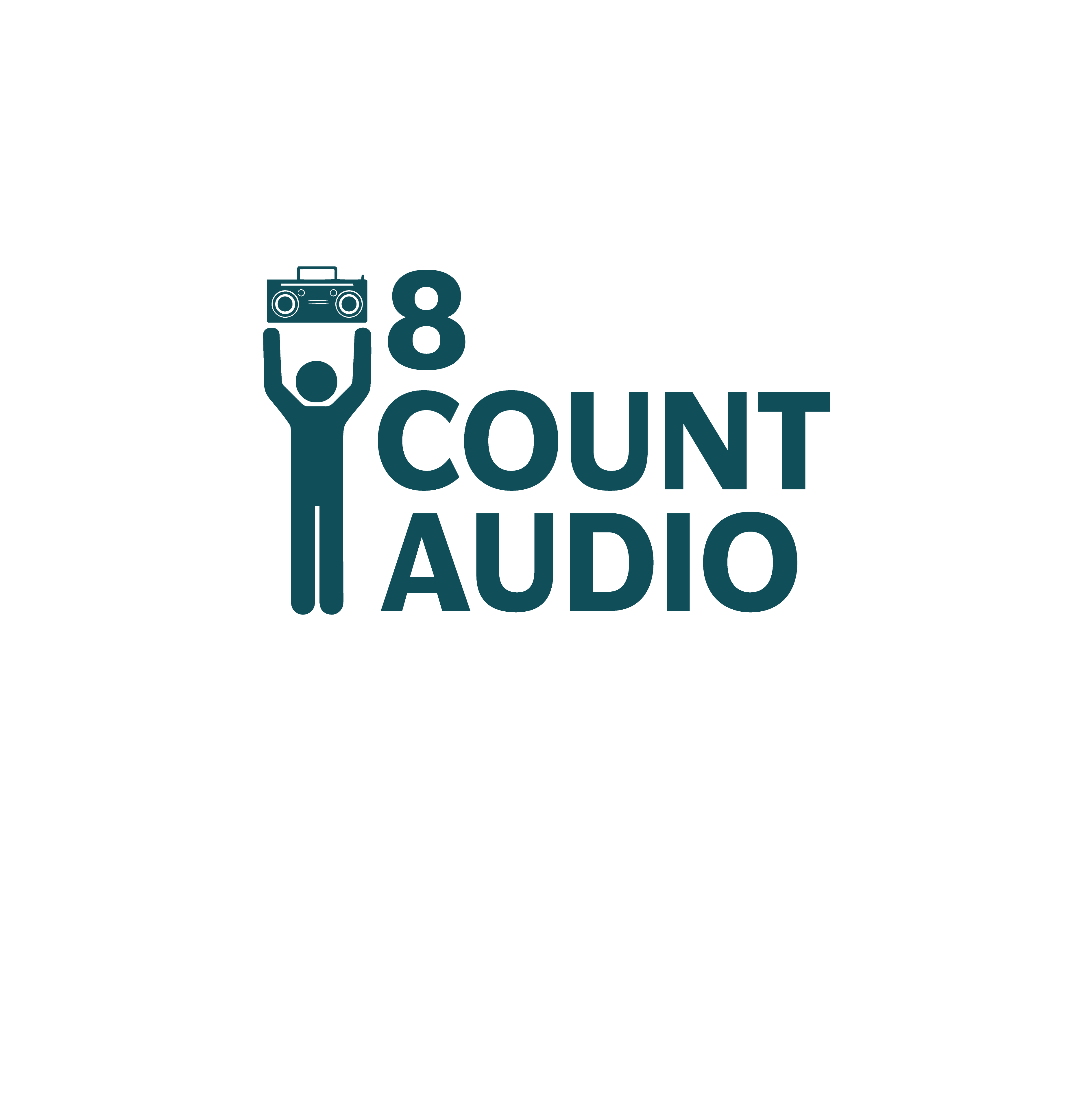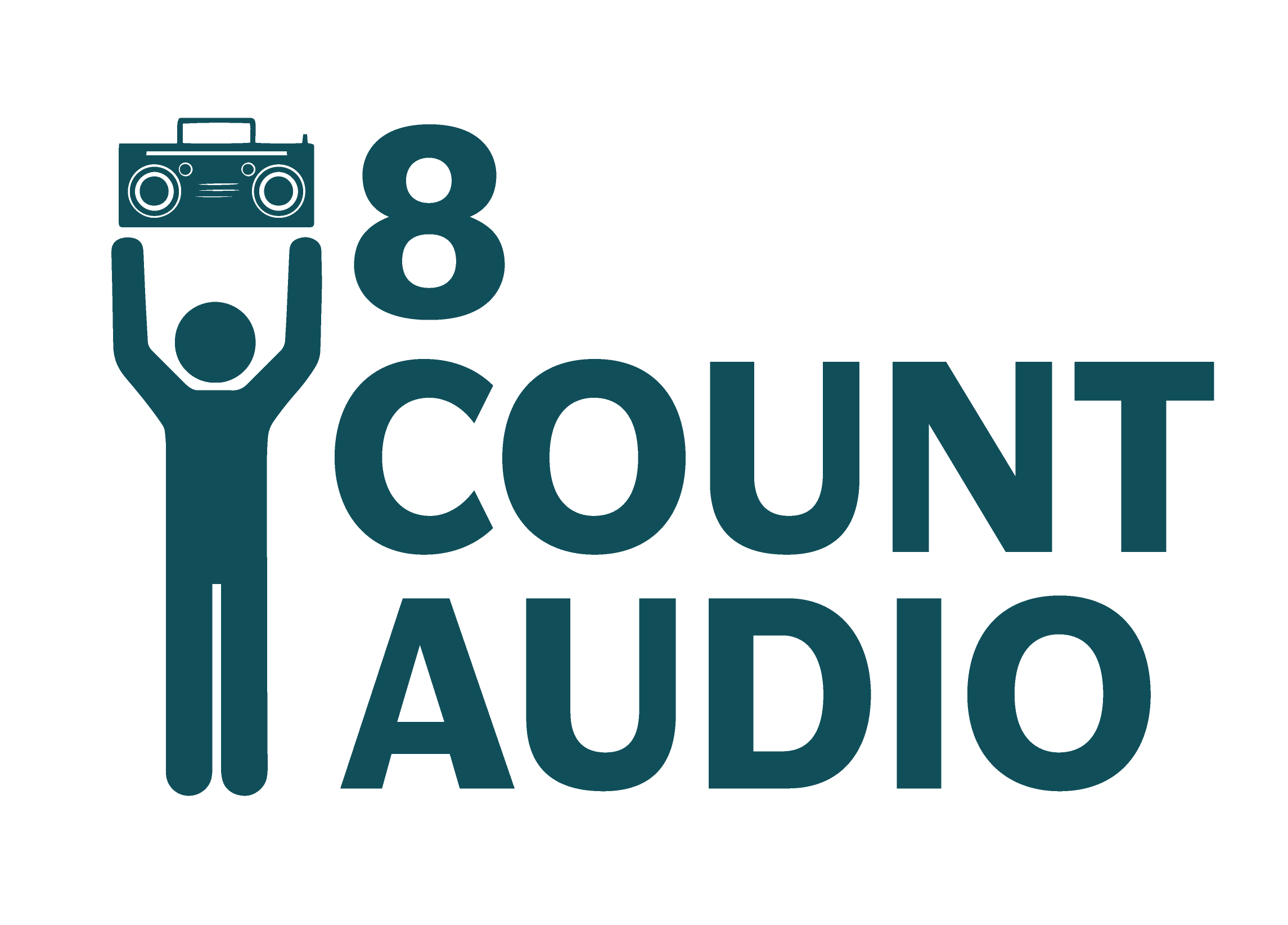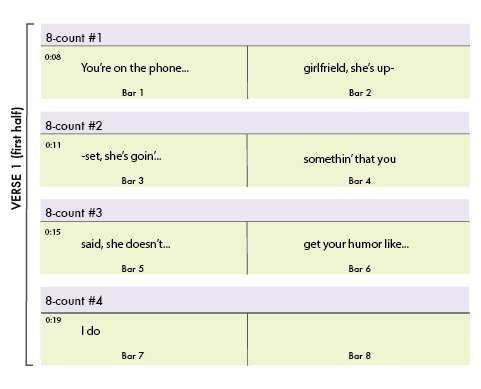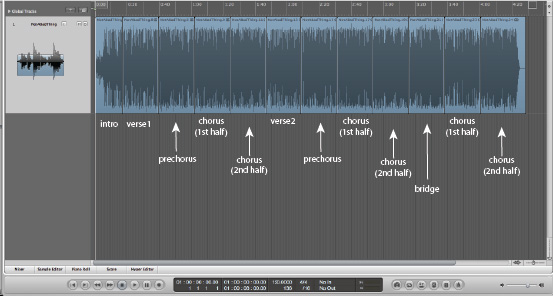Music Editing for Dance Routines: 8 Beginner Tips
Music Editing for Dance Routines: 8 Beginner Tips
by Norm Ramil, 8 Count Audio
Need to edit a single song to make it shorter for your routine? When it comes to choreography, music editing for dance can be tricky but very rewarding. Before you start cutting, there are a few things to figure out first. And once you do start chopping and pasting, you’ll want to also take a step back and make sure your shortened song still sounds musical, which leads to better choreography. Here are 8 rules to live by as you cut a song down to size.
1: Understand song structure
Here’s a basic layout of a typical pop song. The essential parts are an intro, a verse, a chorus, a “wildcard” section, and then a final chorus. The wildcard section is that part of the song that takes an interesting turn before getting back to the final chorus: it could be a bridge, a breakdown, a solo, or a “middle 8” section, or a combination of these (I’ll expand on this idea in a future post).
The optional parts aren’t in every song, but you’ll often find a pre-chorus that goes after the verse and literally sets up the chorus. Many songs will also have a section that sounds like the intro, except it goes between the chorus and verse 2 (it’s a way to transition from the high energy of the chorus back down to the medium energy of the verse). Understanding the song’s anatomy will help you envision what cuts will make sense, and, just as important, which cuts won’t sound great.
2: Think in 8-counts, not seconds and minutes
It helps to know how many 8-counts you’re dealing with in each song section, since 32 seconds of music doesn’t really tell you much in terms of planning your choreography.
Most pop songs are in 4/4 (“four – four”) time, and musicians group together every four beats as a “bar” or a “measure.” That translates easily into the dance world, where you guys consider every eight beats as an “8-count.” So two bars of music equals one 8-count.
Some songs aren’t easily countable if they’re not in 4/4 time. It can get a little complicated, but rest assured that if your song has a triplet feel, you can often still find a way to think of it in terms of fours, and therefore, in terms of 8-counts. More on this in a future post.
When you cut or keep a part of a song, make sure you’re not using fragments of 8-counts. Cutting out (or keeping in) 12 counts (or 1.5 eight-counts) of a section is going to sound uneven and will be difficult for you and your team to count out. There are always exceptions, but this is a good rule to stick to in most cases!
3: What’s the plot line for your choreography?
Where do you want the choreography to go as your song moves from start to finish? Where’s the peak or climax going to be, and how are you going to set it up?
Plenty of factors are involved here, but the basic idea is to have a vision of how you want your routine to proceed from the beginning to the end of the edited song. You’ll want the routine to use the music as a way to unfold new ideas throughout the song, evolving from section to section. This should give you some insight about what parts of the song to keep and where to cut.
Some of the things that could affect your decisions at this point are: the style / category of dance, what judges have said in the past, and your team’s skill level and how it might grow over the next few months.
4: Take advantage of musicality
Every song has multiple layers of creativity: the songwriters, the artists who record the track, and the producers who make the song and its parts sound a certain way. Each of these layers probably has lots of musicality that you can use for your choreography.
Musicality can be a particular moment in the song, but it can also be a gradual development of an idea over several 8-counts.
Maybe the songwriter used a key word or line in the lyrics that’s important to the story of your choreography, or maybe the bridge melody has plenty of tension that would look great translated into choreo. Or it could be that the singer put a little something extra into the energy of verse two, and you might like to take advantage of that in your routine. The little tricks that a producer puts into a song (maybe the start of verse 2 has some cool, echo-y drums for just 4 beats, or there’s a “woosh” sound that leads up to something big) are definitely things to take advantage of as you choreograph.
5: Think evens, not odds
A balanced-sounding song section usually has an even number of 8-counts–typically 4 or 8 of them. You might be tempted to cut out a certain 8-count you don’t like, but to keep things sounding balanced, you’ll want to figure out a way to cut out 2 or 4 eight-counts instead of 1 or 3.
Let’s take Taylor Swift’s “You Belong With Me” as an example. Here’s the first half of verse 1:
Notice that this group of four 8-counts is pretty firm as a single unit. Not only would the lyrics not make sense if you cut out the last 8-count, but the whole thing would sound incomplete. Our ears just seem to like to hear verses and choruses that are made of 4 or 8 eight-counts! Keep this in mind as you cut.
This rule often means that you should try to cut out entire sections instead of just parts of sections. If you are going to cut out part of a section, try to only cut it in half. This strategy would work for our example: the full verse is 8 eight-counts, and if you cut it in half, you’d have 4 eight-counts, which is what you see in the screenshot–and it still sounds like a complete, balanced musical/lyrical thought.
Of course, this is just a general rule, and you can break the rules with some creativity–I’ll cover some of these kinds of tricks in future posts!
6: Zoom out for balance
Now that each section is balanced (either because you kept a section whole or you only cut it in half…as opposed to some weird fraction), you’ll want to make sure that the whole song is balanced.
You’ve probably decided to cut out the least important parts. Do the remaining parts still tell a story like the original song did? And can your choreography tell that story?
Since a good story has a beginning, middle, climax, and ending, make sure your shortened song still has some kind of intro, a verse, a chorus, something interesting after that (the “wildcard” section I talked about in #1 above), and then a final chorus or outro. It’s definitely possible to have all of that in 2 minutes and 30 seconds, and it’s usually do-able under 2 minutes for UDA routines or halftime performances.
7: Use your eyes
If you’ve cut up your song and have arranged the pieces, does it look balanced? Here’s a screenshot of the original length of Justin Timberlake’s “Not A Bad Thing”:
I’ve cut the song up into sections, and you’ll notice how every section looks like the same length as the others (each is four 8-counts long). Your shortened version should try to stick to this kind of visual balance. That doesn’t mean that each section has to be the same length, but by just looking at how your edited song appears on your screen, you can spot a section that maybe goes on too long or isn’t long enough.
If something looks out of balance on the screen, it’ll sound uneven, and the choreography will likewise feel and look unsettled.
8: Use your ears
Take a break (maybe an hour, but ideally a day). Come back with fresh ears and listen to your finished product: does any one section go on for too long compared with other sections? Is there a musical idea that seems unfinished? Is there enough tension, and is it followed by resolution? Is the climax obvious?
I’ll get into actual cutting techniques in the next few posts, but for now, let’s suppose that your edits sound good, clean, and natural. Would someone hearing your edited song say, “ok, it’s a mini-version of the full song,” or would she say, “whoa–that was kinda crazy?” If you’re using a well-known track, people have some pretty firm expectations of how the song should sound. By sticking to these basic editing rules, you can take a big step toward keeping the audience focused on your choreography over the music.
Up next:
I’ll get into the details of editing techniques for single songs, tricks to use and enhance musicality, and some creative edits to get around typical cutting challenges. If you’d rather have your song professionally cut, send me a message and you can stay focused on choreography instead of music decisions!




